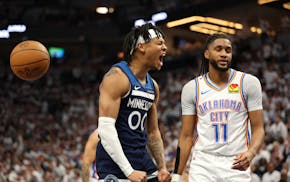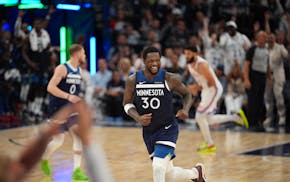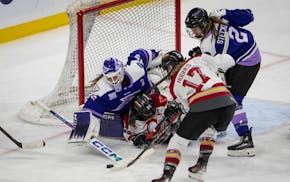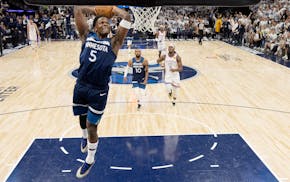After the Vikings closed their practice facility in Eagan in March, Kyle Rudolph found himself with three days to train outside his home at a workout facility that was yet to shut down.
It turned out to be a happy accident that sparked the veteran tight end to buy a piece of equipment that he believes will help him emerge from quarantine as fit as he would be in a normal offseason.
Rudolph stopped in to Exos Minneapolis, where he had trained before the Vikings opened their expansive facility in 2018, and found the Timberwolves had just installed two units of Tonal, a smart home gym that uses digital weights and artificial intelligence-based training programs. Rudolph had been interested in purchasing one for his wife, Jordan, to use at their home in Plymouth, but after he was able to try the program out in Minneapolis, he knew it could help him train for his 10th NFL season as well.
He's been training with it at home for two weeks now; the quality of the workouts, he said, are in line with what he's typically had at the Vikings' facility.
NFL, union approve virtual off-season workout programs
"It really does allow me to get that same work I'm accustomed to getting," Rudolph said. "I don't have to bring in a bunch of free weights and barbells and dumbbells; anything that I would be doing at the facility with that equipment, I'm able to do on the Tonal."
Rudolph's improvisation is one of the ways NFL players are adapting to a pandemic that has disrupted life around the globe and jarred a sports industry built on mechanistic certainty.
“I can just magnify it to the point where I have to do everything I can to prepare myself, both physically and mentally, to be ready for things to open back up tomorrow.”
The NFL is the only major American sports league yet to postpone games, but with team facilities closed and the league shifting to a "virtual offseason" program, players could soon trade OTAs for more of the DIY training approach.
While Vikings quarterback Kirk Cousins largely has been able to maintain his fitness plan at the gym in his house on the shores of Lake Michigan, his trainer, Joe Tofferi, has loaned out weights to younger clients such as Packers running back Aaron Jones and ordered equipment from Amazon for players who don't have their own.
Social distancing restrictions have prevented Shawn Myszka from planning normal movement training sessions for clients such as former Vikings Everson Griffen, Xavier Rhodes and Trae Waynes; he instead has used chase games with their kids or dogs to inject an element of unpredictability.
"It's not like 'Rocky II' — I'm not quite buying anyone any chickens [to chase]," Myszka said with a laugh. "But you have a certain level of movement problem-solving in your life; I think there's a certain amount of repetition without repetition, even if isn't really a representative problem."
The deal that the league agreed to with the NFL Players Association on Monday reportedly allows teams to send up to $1,500 of workout equipment, or a stipend for the same amount, for each player who lacks equipment to train at home. The Vikings, who would have been scheduled to start offseason workouts April 20, will be able to send training programs to players under the new agreement.
The disruption to players' offseasons has been minimal so far, but if states extend mitigation strategies far enough into the summer to cancel training camps, it could be a different story. Rudolph, who was a rookie when the 2011 lockout extended into training camp, said this year's rookies could find themselves dealing with a similarly brief indoctrination period.
"I can just magnify it to the point where I have to do everything I can to prepare myself, both physically and mentally, to be ready for things to open back up tomorrow," he said.
Training at a (social) distance
The suddenness with which shutdowns took effect across the country last month, and the uncertainty about when they will end, left some players — particularly those who live and train in different locales — scrambling on multiple fronts. For trainers such as Tofferi, it's meant helping his 12 NFL clients make the best of what they have available.
He's shifted the way he structures offseason training, emphasizing plyometrics and speed work for players who have hilly streets and open fields instead of weights. Jones, who is coming off a season in which he led the NFL with 19 touchdowns, is aiming to add 20 pounds before the start of next season; Tofferi has used the time to focus on the running back's nutrition, knowing they'll have time to focus more extensively on workouts later.
His plan with Cousins, Tofferi said, hasn't changed much at this point — the two log most of their face-to-face time in Michigan during the weeks between minicamp and training camp. Tofferi gives the quarterback his space, aware that Cousins "knows his body probably as much as I do."
"If my son needed training at the quarterback position, as far as strength and conditioning goes, [Cousins would] probably be in the top three people I'd send him to, just because he's so intelligent," Tofferi said.
Myszka said he's continued to work in person with two linebackers who are returning from injuries last season. But they have had to alter their workouts to stay within social distancing guidelines, such as running drills where they're staying at least 6 feet apart and refraining from using a football. He sends video of the sessions to the athletic training staff from each player's team, communicating with the clubs about what they'd like to happen next, and is exploring ways to adopt virtual reality technology used by European soccer and rugby players in their own rehab.
"It's more about distance management — getting them very sensitive to their spacing, their timing of their actions," he said. "Not a lot of football problems involve 2 yards of separation at all times. If you're a defender, you're trying to close into that gap, and if you're an offensive skill player, you're trying to exploit that space. … To find problems that behave in that 6-foot, or 2-yard, window has forced me to reflect on football movement problems a little differently."
'This is going to be a test'
While players adjust to the loss of more traditional training methods in the spring, they're grappling with the uncertainty of what the 2020 seasons will look like if there's no training camp.
Tofferi and Myszka, who spend much of their time with players on video calls at this point, both said they function as something of a sounding board for younger clients who worry what lost practice time could mean for their development and career prospects.
Rudolph has felt it too, as the longest-tenured player on the Vikings' roster. He's heard more from younger players reaching out for advice than he typically would at this point in the offseason, and he expects that to continue if the shutdown stretches into the summer.
The Vikings went 3-13 in his rookie season, with a new coaching staff and revamped roster unable to coalesce before the start of the year. The 2020 Vikings should have a stronger core of veterans than the 2011 group did, but they're still headed into a year of change.
"For the first time in the course of [coach Mike Zimmer's] seven years here, we're going to have a lot of new faces on our team," Rudolph said. "It would be great to have these workouts in Phase 1, Phase 2, Phase 3 of our offseason to come together as a team, because there are going to be so many new faces. But we can't control the circumstances. For us, it will put that much more of an onus on the veteran guys who have been here before, who know the standard we operate at, and bring those new guys in as quickly as possible."
Though players may loathe offseason workouts and training camp, coaches bridle at development time for younger players that has been lost through recent collective bargaining agreements. The lead-up to the season could provide a crucible for how much players can manage their own preparation.
"This is going to be a test to see what the NFL actually needs as far as offseason work," Tofferi said. "I think camp's even going to be shortened, if I were going to guess. How they respond to this is going to be a direct indicator of what's going to happen the next couple years."

Timberwolves takeaways from Game 3: The game had barely begun and the Thunder was done

Live updates: Timberwolves respond in Game 3, hammer Oklahoma City

Neal: Frost goaltender Maddie Rooney stands tall — and stands up for her teammates on defense

Minnesota United and Austin play to a 1-1 draw at Allianz Field

